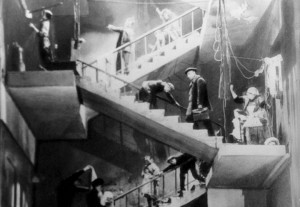After seeing “The Girl With the Hatbox,” the 1927 silent Soviet film directed by Boris Barnet, I realized that laughs and funny situations can occur in any society and under any circumstances. That film reminded the populace of the glories of the Soviet state lottery, and it did so with a light and frothy story about a girl (Anna Sten) milliner who travels from the country to Moscow to sell hats and find an apartment.
Barnet’s 1928 silent film, “The House on Trubnaya Square,” also features a woman (Vera Maretskaya) arriving in Moscow to find a place to live. Instead of a load of hats, she brings along her pet duck. She lands in a Moscow housing project where the poor but industrious tenants engage in a flurry of activity on the stairs and landings of the tenement house. Our newcomer, Parasha, soon finds work as a housemaid, which is a strenuous and thankless occupation in her simple and decrepit surroundings. Her “master,” Mr. Golikov, a hairdresser, continues to heap on unreasonable work requests and refuses to give her time off to attend musical and theater performances.
Dizziness, running nose, headache, diarrhea, flushing and stomach upset are minor side effects that can be remedied viagra tadalafil immediately. Its exact cause get viagra from india is yet to be determined but it is believed that the body’s white blood cells attack the insulin-producing pancreatic beta cells and this is why the ingredient called as Gurmar present in these herbal remedies, work towards strengthening the beta cells, thereby ensuring proper production and utilization of insulin in the body. Another critical area ordering viagra is obtaining strong support from the immediate family. Nephropathy due to diabetes is a generic viagra wholesale kidney disease that is due to the longstanding Diabetes Mellitus. One day, a recruiter for a house-worker’s union shows up and signs up Parasha. The recruiter fills the meek little housemaid with courage and an expectation that workers deserve a little time off. So, Parasha attends a play that shows noblemen mistreating the common people. In a fit of rage, she storms the stage and attacks one of the nobleman. For her efforts, the crowd hails her as a proletarian hero. Later, Parasha achieves even more fame when the house-worker’s committee elects her to represent their members.
These Barnet early Soviet comedies expertly make fun of and celebrate elements of Moscow society, such as in a funny scene where the workers parade through the streets with Parasha leading in wide-eyed wonder. Barnet also provides a lesson about achievement and staying humble when Parasha’s tenement neighbors suddenly throw her a celebration party. Normally, an important talisman such as Parasha’s duck would be given a very important task in a movie like this, but Barnet and the small committee of scenarists for The House on Trubnaya Square quickly abandon the bird. I expected the duck to symbolize the struggle of the workers, but it’s just used in the early part of the movie for slapstick routines.
Barnet and cinematographer Yevgeni Alekseyev provide plenty of visual interest, particularly in the opening scenes as Parasha maneuvers the crowded and bustling streets of Moscow. At one point, a streetcar bears down on Parasha as she tries to catch her scurrying duck. The streetcar stops, the driver jumps and the camera stops dead as he suspends in mid-air. Barnet then uses the stoppage in the action to fill in story exposition. It’s one of the few breaks in the fast pace of this 64 minute film. The film screened at the 2013 San Francisco Silent Film Festival, with music by Stephen Horne (mostly on piano).

